Microbiology - Section 1, Lesson 1
1/175
There's no tags or description
Looks like no tags are added yet.
Name | Mastery | Learn | Test | Matching | Spaced |
|---|
No study sessions yet.
176 Terms
At the simplest level of construction, all cells possess a few fundamental components. These include what?
cytoplasm, which is contained within a plasma membrane; one or more chromosomes, and ribosomes
At the simplest level of construction, all cells possess a few fundamental components. These include cytoplasm contained in a plasma membrane. What is cytoplasm and what is the membrane?
Cytoplasm - a gel-like substance composed of water and dissolved chemicals needed for growth, which is contained within a
Plasma membrane - also called a cell membrane or cytoplasmic membrane
At the simplest level of construction, all cells possess a few fundamental components. These include one or more chromosomes. Why are these important?
They contain the genetic blueprints of the cell
At the simplest level of construction, all cells possess a few fundamental components. These include a ribosomes. What are these?
organelles used for the production of proteins

how are the two largest categories of cells (prokaryotic and eukaryotic) differentiated?
by major differences in several cell structures.
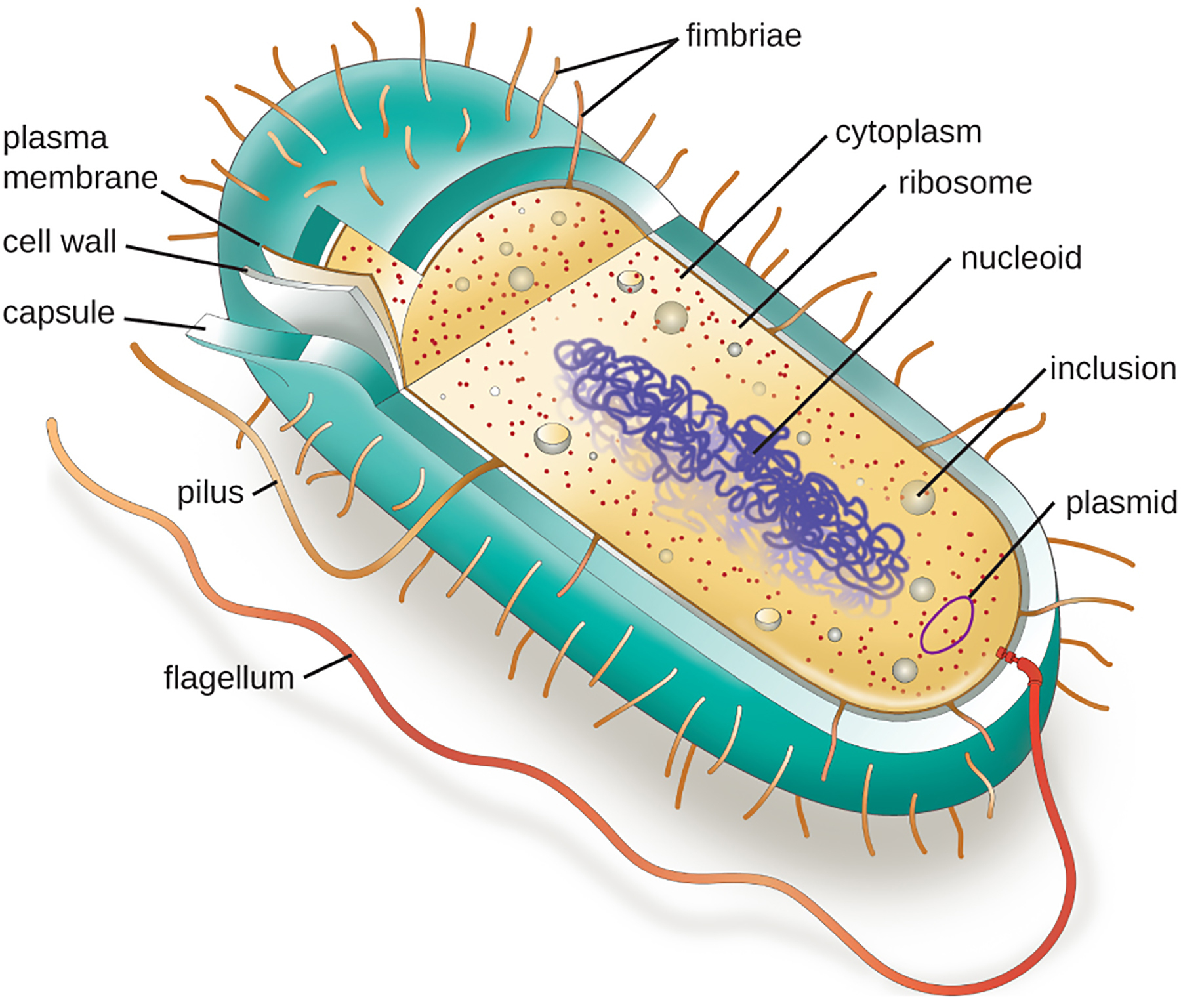
What are examples of differences between prokaryotic and eukaryotic cells?
Prokaryotic cells lack a nucleus surrounded by a complex nuclear membrane and generally have a single, circular chromosome located in a nucleoid. Eukaryotic cells have a nucleus surrounded by a complex nuclear membrane that contains multiple, rod-shaped chromosomes
what are the prokaryotic domains
Archaea and Bacteria
what are the eukaryotic domains
the domain Eukarya

What is cell morphology?
cell shape, structure, and arrangement, as viewed microscopically
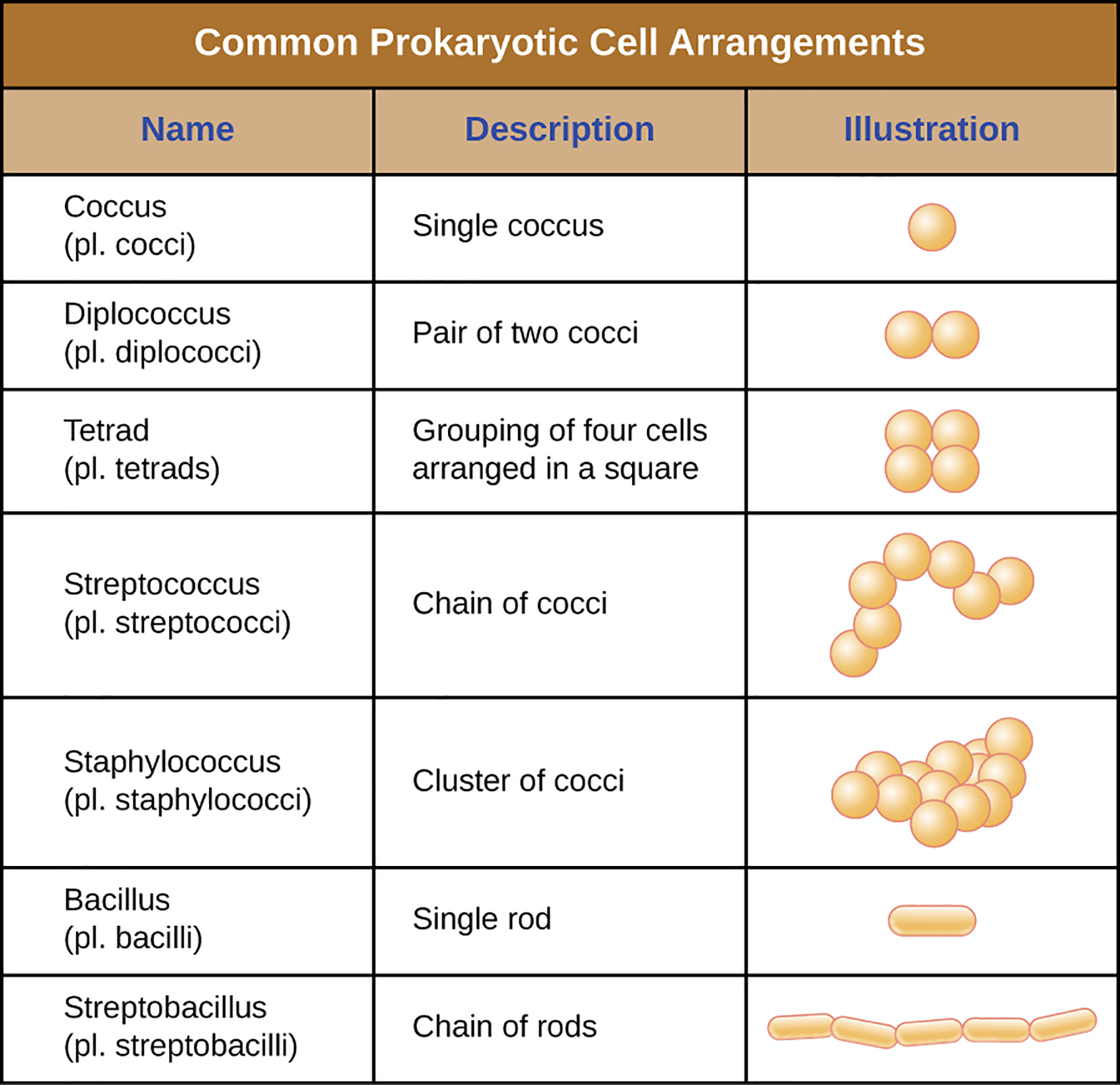
what is a prokaryotic arrangement?
In addition to cellular shape, prokaryotic cells of the same species may group together in certain distinctive arrangements depending on the plane of cell division.
how is cell morphology maintained?
by the cell wall in combination with cytoskeletal elements. The cell wall is a structure found in most prokaryotes and some eukaryotes; it envelopes the cell membrane, protecting the cell from changes in osmotic pressure
What is osmotic pressure?
the force or pressure generated by water diffusing across a semipermeable membrane, driven by differences in solute concentration across the membrane
Why does osmotic pressure occur?
because of differences in the concentration of solutes on opposing sides of a semipermeable membrane. Water is able to pass through a semipermeable membrane, but solutes (dissolved molecules like salts, sugars, and other compounds) cannot.
What is osmosis?
When the concentration of solutes is greater on one side of the membrane, water diffuses across the membrane from the side with the lower concentration (more water) to the side with the higher concentration (less water) until the concentrations on both sides become equal.
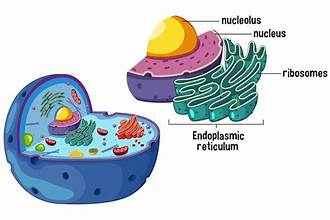
what is a ribosome?
a complex intracellular structure that synthesizes proteins
What is a prokaryotic cell?
a cell lacking a nucleus bound by a complex nuclear membrane
lacking membrane bound organelles, such as nucleus, mitochondria, and chloroplasts
What is a eukaryotic cell?
has a nucleus surrounded by a complex nuclear membrane that contains multiple, rod-shaped chromosomes
What organisms are included under the eukaryotic domain?
protozoans, algae, fungi, plants, and animals. Some eukaryotic cells are independent, single-celled microorganisms, whereas others are part of multicellular organisms
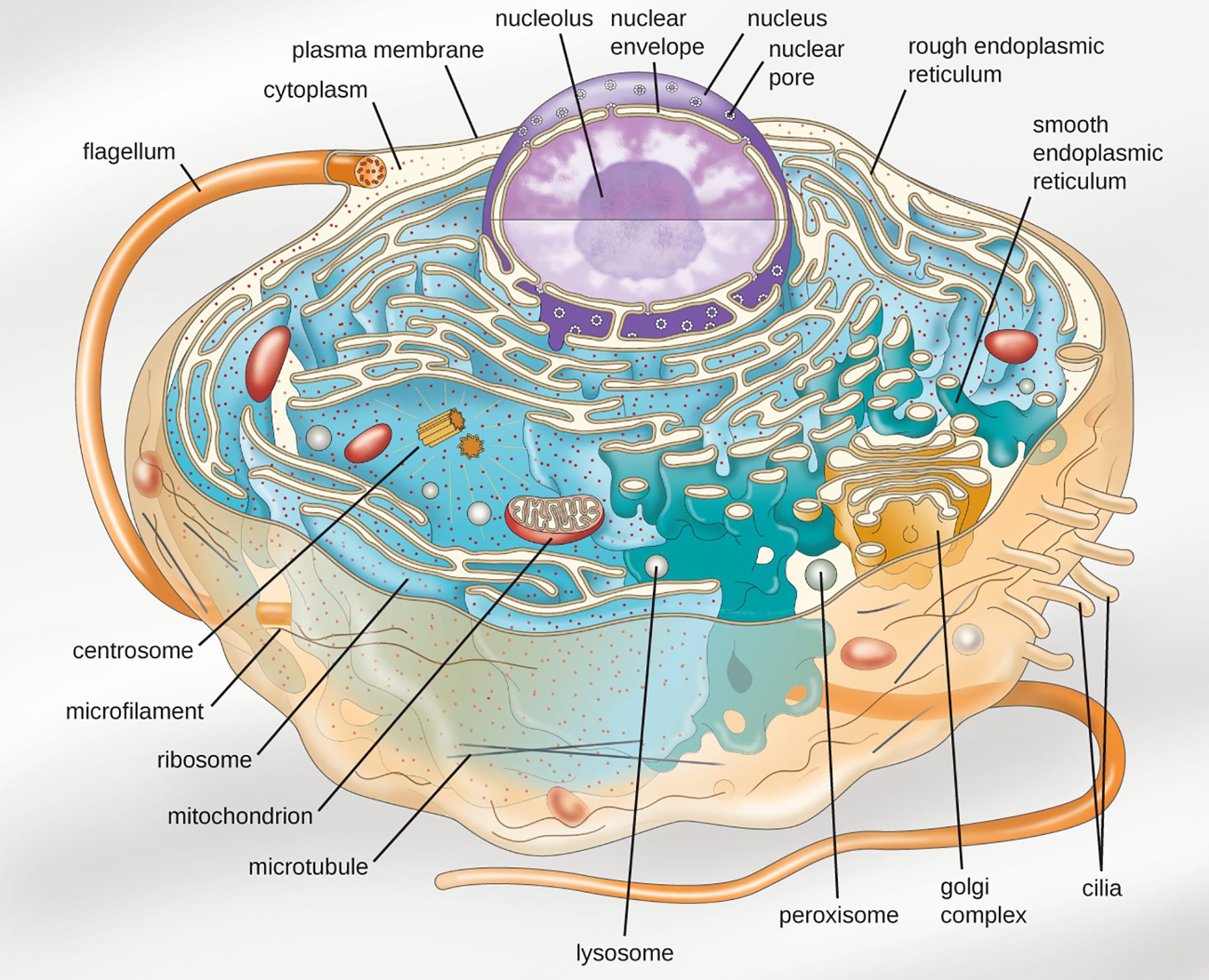
What defines a eukaryotic cell?
the presence of a nucleus surrounded by a complex nuclear membrane. Also, eukaryotic cells are characterized by the presence of membrane-bound organelles in the cytoplasm. Organelles such as mitochondria, the endoplasmic reticulum (ER), Golgi apparatus, lysosomes, and peroxisomes are held in place by the cytoskeleton, an internal network that supports transport of intracellular components and helps maintain cell shape
Prokaryotic Cell Structure: What is the Size?
Bacteria ~0.5–1 μm
Archaea ~0.5–1 μm
Prokaryotic Cell Structure: What is the surface area to volume ratio?
Bacteria High
Archaea High
What is surface area to volume ratio?
a ratio that compares the surface area of an object to its volume
Prokaryotic Cell Structure: Do these have a nucleus?
Bacteria No
Archaea No
Prokaryotic Cell Structure: What are some Genome characteristics?
Bacteria -
Single chromosome
Circular
Haploid
Lacks histones
Archaea -
Single chromosome
Circular
Haploid
Contains histones
Difference - Histones
Prokaryotic Cell Structure: How do cells divide?
Binary Fission
What is Binary Fission
a method of asexual reproduction used by prokaryotes (bacteria and archaea) where a single cell divides into two genetically identical daughter cells
Prokaryotic Cell Structure: What is the membrane composition like?
Bacteria -
Ester-linked
Straight-chain fatty acids
Bilayer
Archaea -
Ether-linked
Branched isoprenoids
Bilayer or monolayer

What is an ester linkage?
formed through a condensation reaction between a carboxylic acid and an alcohol, with the release of water as a byproduct. This process is crucial in the synthesis and metabolism of lipids, such as fats and oils.
Prokaryotic Cell Structure: What is the cell wall composition like?
Bacteria -
Peptidoglycan, or
None
Archaea - many more options
Pseudopeptidoglycan, or
Glycopeptide, or
Polysaccharide, or
Protein (S-layer), or
None
Prokaryotic Cell Structure: what are the motility structures?
Bacteria -
Rigid spiral flagella composed of flagellin
Archaea -
Rigid spiral flagella composed of archaeal flagellins
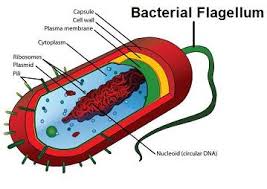
Prokaryotic Cell Structure: Do these have membrane bound organelles?
Bacteria - No
Archaea - No
Membrane-bound organelles are specialized compartments within eukaryotic cells that are enclosed by a biological membrane
Prokaryotic Cell Structure: Endomembrane System?
Bacteria - No
Archaea - No
The endomembrane system is a network of membranes and organelles in eukaryotic cells that work together to modify, package, and transport proteins and lipids
Prokaryotic Cell Structure: What are the ribosomes?
Bacteria - 70S
Archaea - 70S
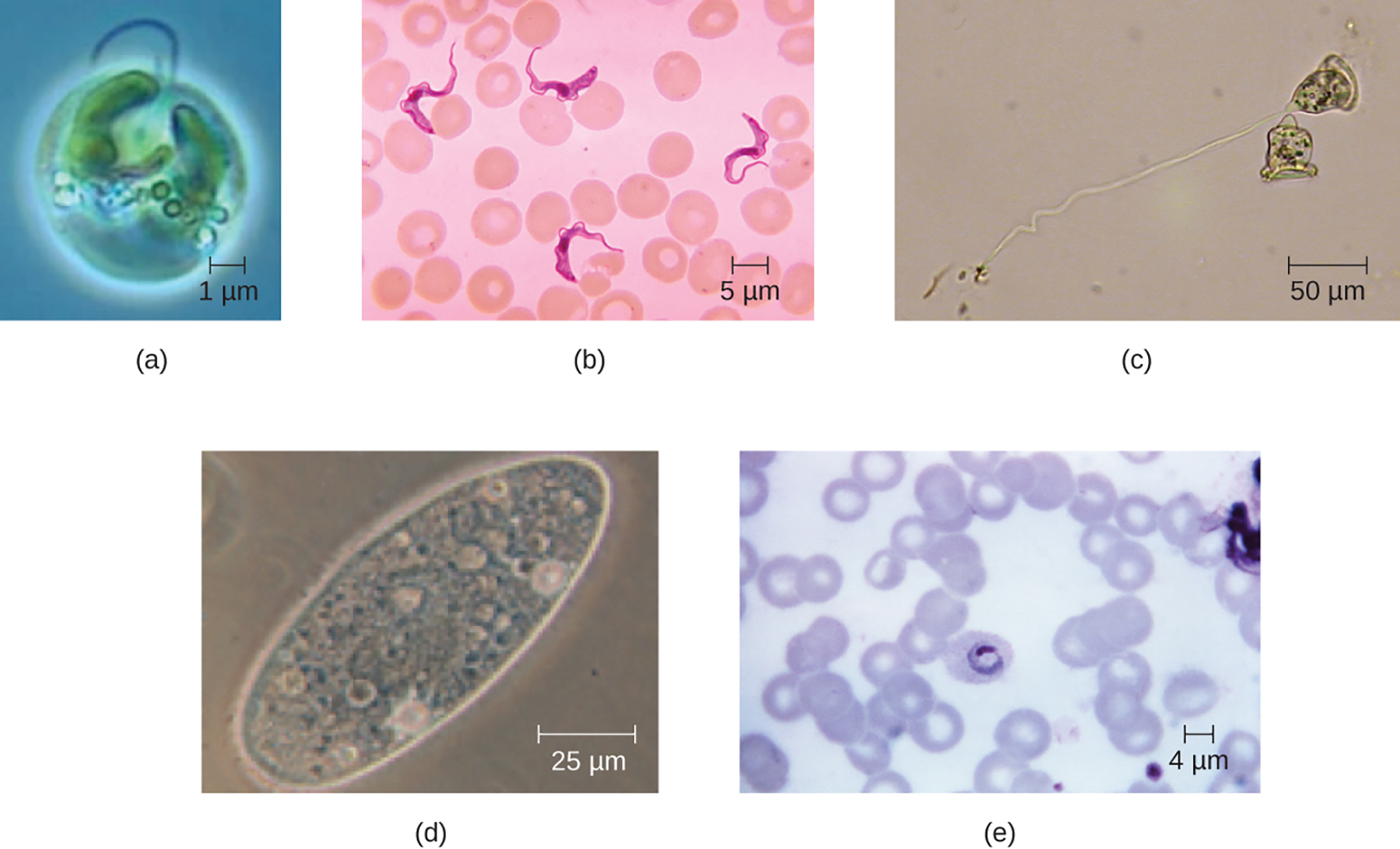
What is eukaryotic cell morphology?
Possible shapes include spheroid, ovoid, cuboidal, cylindrical, flat, lenticular, fusiform, discoidal, crescent, ring stellate, and polygonal. Some eukaryotic cells are irregular in shape, and some are capable of changing shape
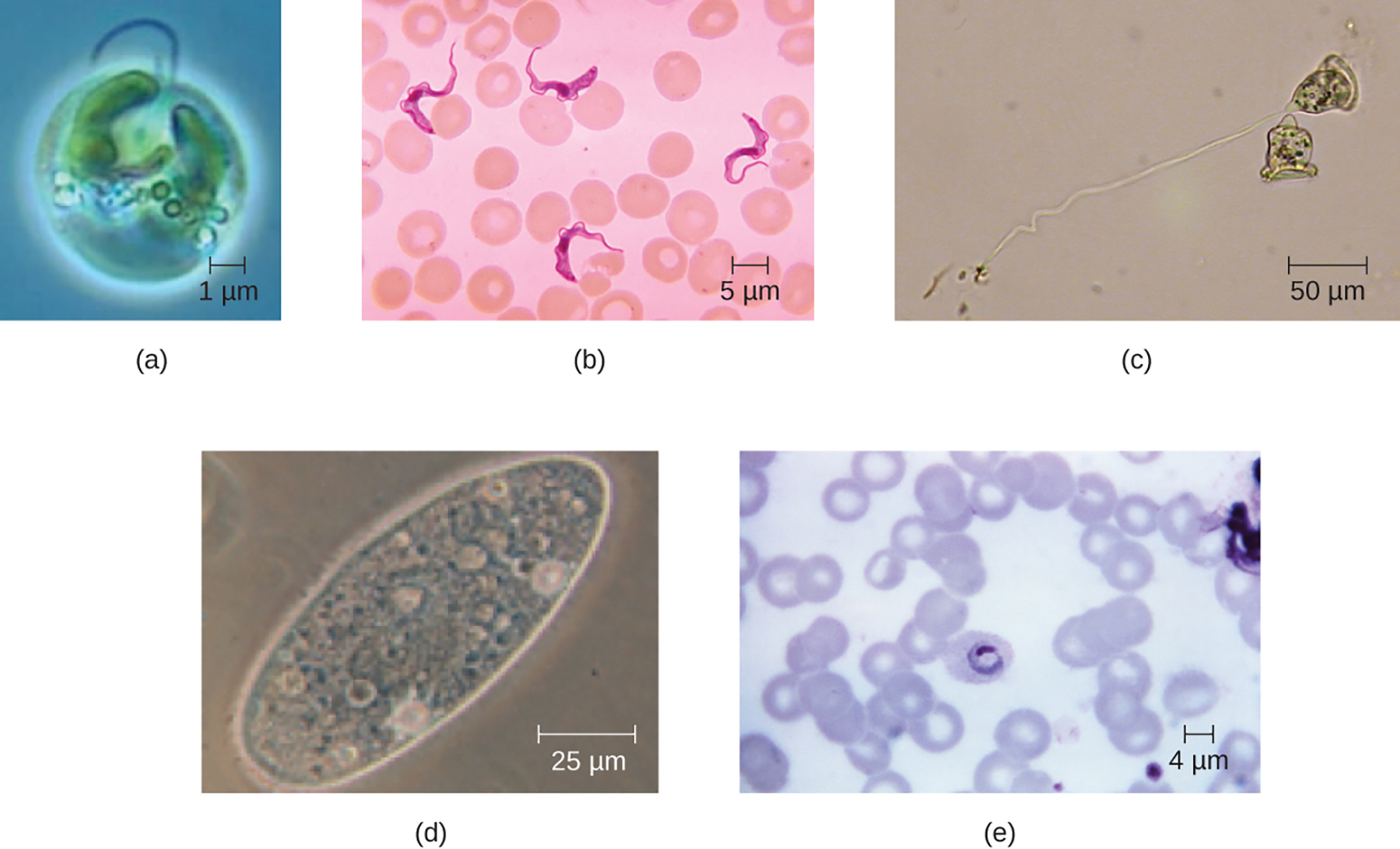
What is the importance of eukaryotic cell morphology?
The shape of a particular type of eukaryotic cell may be influenced by factors such as its primary function, the organization of its cytoskeleton, the viscosity of its cytoplasm, the rigidity of its cell membrane or cell wall (if it has one), and the physical pressure exerted on it by the surrounding environment and/or adjoining cells.
What is a cytoskeleton?
an internal network that supports transport of intracellular components and helps maintain cell shape
eukaryotic cells possess a nucleus, which is surrounded by a complex nuclear membrane that houses the DNA genome. How is this different from Prokaryotic cells?
DNA is loosely contained in the nucleoid region in prokaryotic cells.
eukaryotic cells possess a nucleus surrounded by a complex nuclear membrane that houses the DNA genome. Why is this beneficial?
by containing the cell’s DNA, the nucleus ultimately controls all activities of the cell and also serves an essential role in reproduction and heredity.
How are the DNA organized in nuclei (Eukaryotic cells)?
typically have their DNA organized into multiple linear chromosomes. The DNA within the nucleus is highly organized and condensed to fit inside the nucleus, which is accomplished by wrapping the DNA around proteins called histones.
How many nuclei do eukaryotic cells have?
most eukaryotic cells have only one nucleus, exceptions exist. For example, protozoans of the genus Paramecium typically have two complete nuclei: a small nucleus that is used for reproduction (micronucleus) and a large nucleus that directs cellular metabolism (macronucleus). Additionally, some fungi transiently form cells with two nuclei, called heterokaryotic cells, during sexual reproduction.
The nucleus in a eukaryotic cell is bound by a complex nuclear membrane, often called the nuclear envelope. What does this consist of?
two distinct lipid bilayers that are contiguous with each other
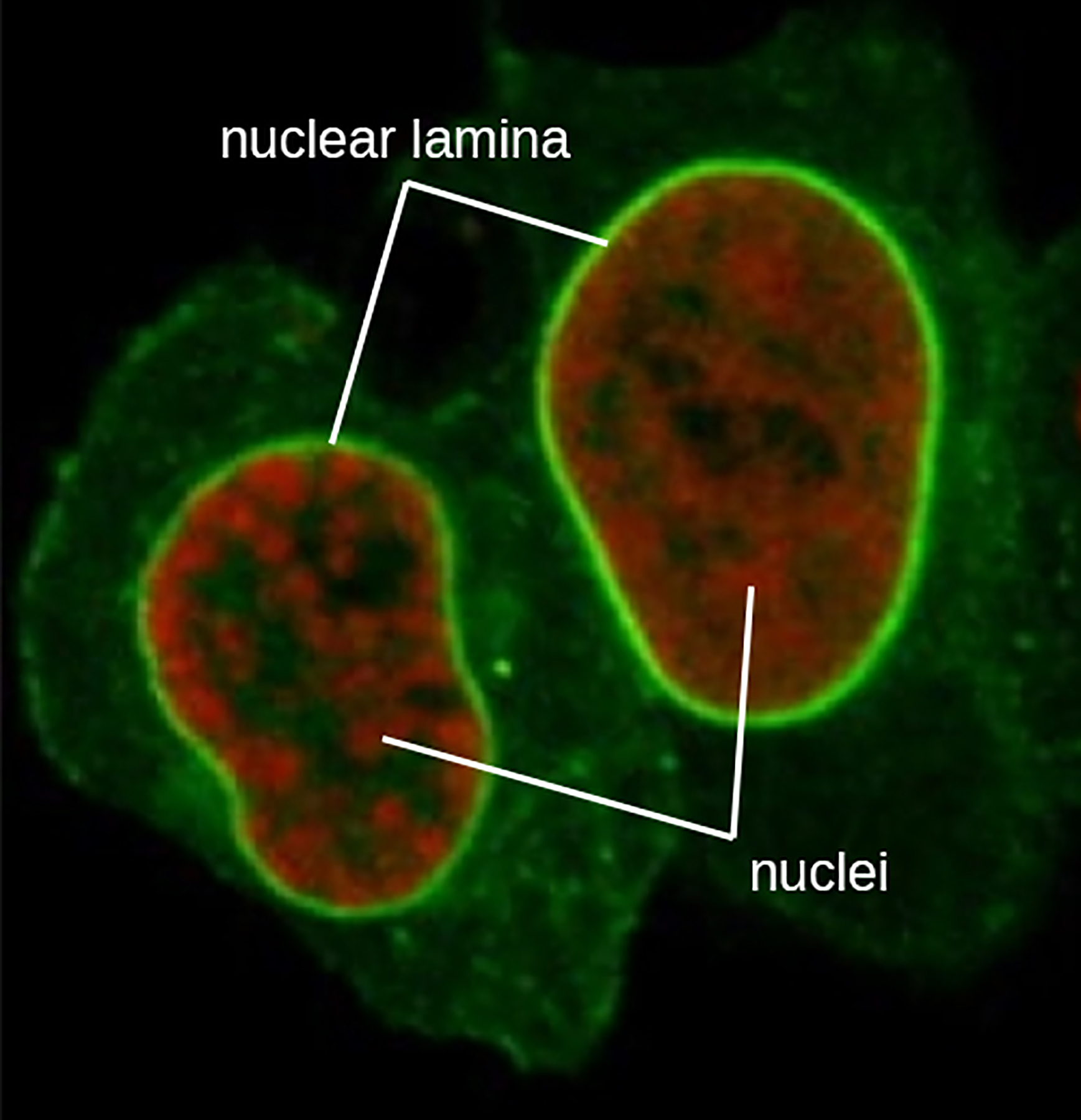
What determines the shape of the nucleus?
the nuclear lamina, a meshwork of intermediate filaments found just inside the nuclear envelope membranes.
What is a nuclear membrane?
a structure defining the boundary of the nucleus; composed of two distinct lipid bilayers that are contiguous with each other and with the endoplasmic reticulum
What is a nuclear envelope?
(also called the nuclear membrane) a structure defining the boundary of the nucleus; composed of two distinct lipid bilayers that are contiguous with each other and with the endoplasmic reticulum
What is a nuclear lamina?
a meshwork of intermediate filaments found just inside the nuclear envelope membranes
What anchors the nucleus in position in a cell?
Outside the nucleus, additional intermediate filaments form a looser mesh and serve to anchor the nucleus in position within the cell.
How is asexual reproduction mitosis in eukaryotic cells different from asexual binary fission in prokaryotes
In contrast to the single chromosome in most prokaryotes, eukaryotic cells possess multiple chromosomes that must be replicated and strategically divided between daughter cells. Therefore, mitosis is a much more complex cellular process than binary fission.
What are the 2 options of reproduction for eukaryotes?
mitotic asexual reproduction and the option of sexual reproduction involving meiosis.
While both require DNA replication, involve nuclear division, and share procedural similarities, there are important differences between the process and outcomes, what is the difference between mitosis and meiosis
meiosis involves two separate nuclear divisions. Rather than creating two clonal daughter cells, the goal of meiosis is to create four genetically distinct gametes, with each gamete possessing half the number of chromosomes found in the original cell. This strategic chromosome reduction is essential for the fertilization that occurs during sexual reproduction to produce in a zygote with a full complement of chromosomes.
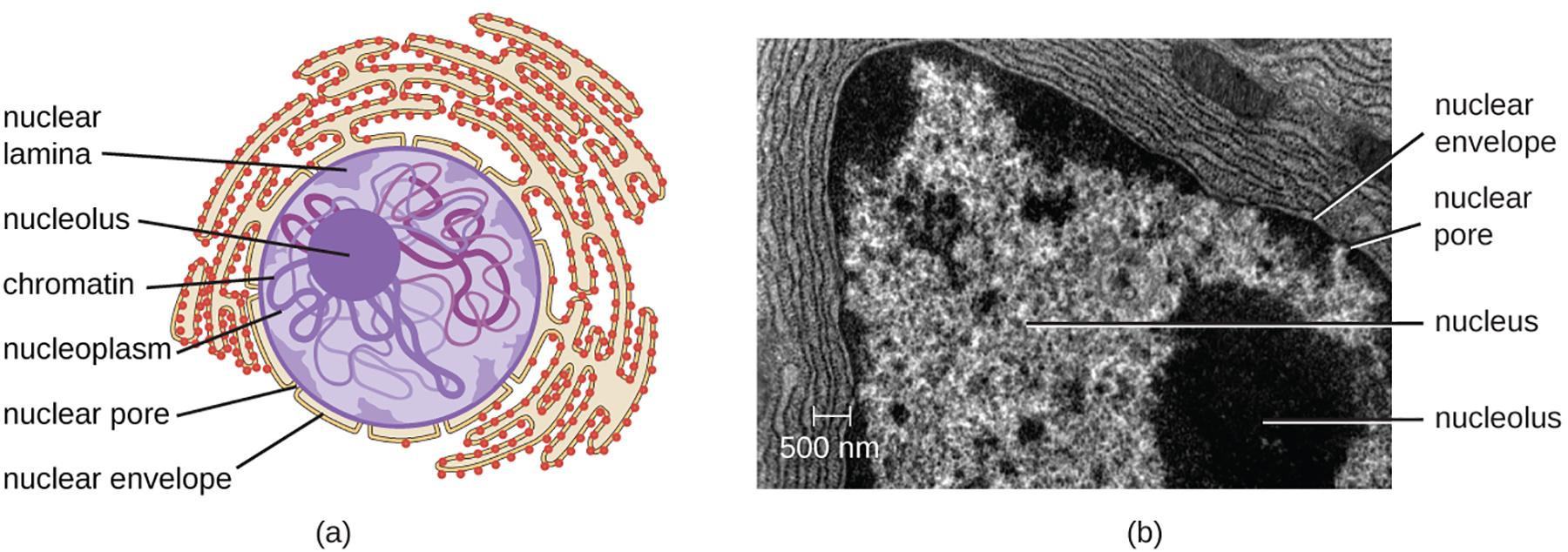
What is the nucleolus
a dense region within the nucleus where ribosomal RNA (rRNA) biosynthesis occurs.
The nucleolus is a dense region within the nucleus where ribosomal RNA (rRNA) biosynthesis occurs. What else occurs here?
assembly of ribosomes begins. Preribosomal complexes are assembled from rRNA and proteins in the nucleolus; they are then transported out to the cytoplasm, where ribosome assembly is completed
what are the size of ribosomes found in eukaryotic organelles such as mitochondria or chloroplasts?
70S ribosomes—the same size as prokaryotic ribosomes.
what are the size of ribosomes found in eukaryotic nonorganelle-associated ribosomes?
80S ribosomes, composed of a 40S small subunit and a 60S large subunit.
How are the two types of nonorganelle-associated eukaryotic ribosomes defined
by their location in the cell: free ribosomes and membrane-bound ribosomes
Where are free ribosomes found?
in the cytoplasm and serve to synthesize water-soluble proteins;
Where are membrane-bound ribosomes found
attached to the rough endoplasmic reticulum and make proteins for insertion into the cell membrane or proteins destined for export from the cell.
Why are the differences between eukaryotic and prokaryotic ribosomes clinically relevant
because certain antimicrobial drugs are designed to target one or the other .For example, cycloheximide targets eukaryotic ribosomes, whereas chloramphenicol targets prokaryotic ribosomes (Barnhill et al., 2012).
Although antibiotics that destroy the prokaryotic ribosomes in bacteria don’t typically harm human cells (eukaryotic), what might happen
sometimes negative side effects may occur because mitochondria in human cells contain prokaryotic ribosomes.
What is endomembrane system, unique to eukaryotic cells?
a series of membranous tubules, sacs, and flattened disks that synthesize many cell components and move materials around within the cell
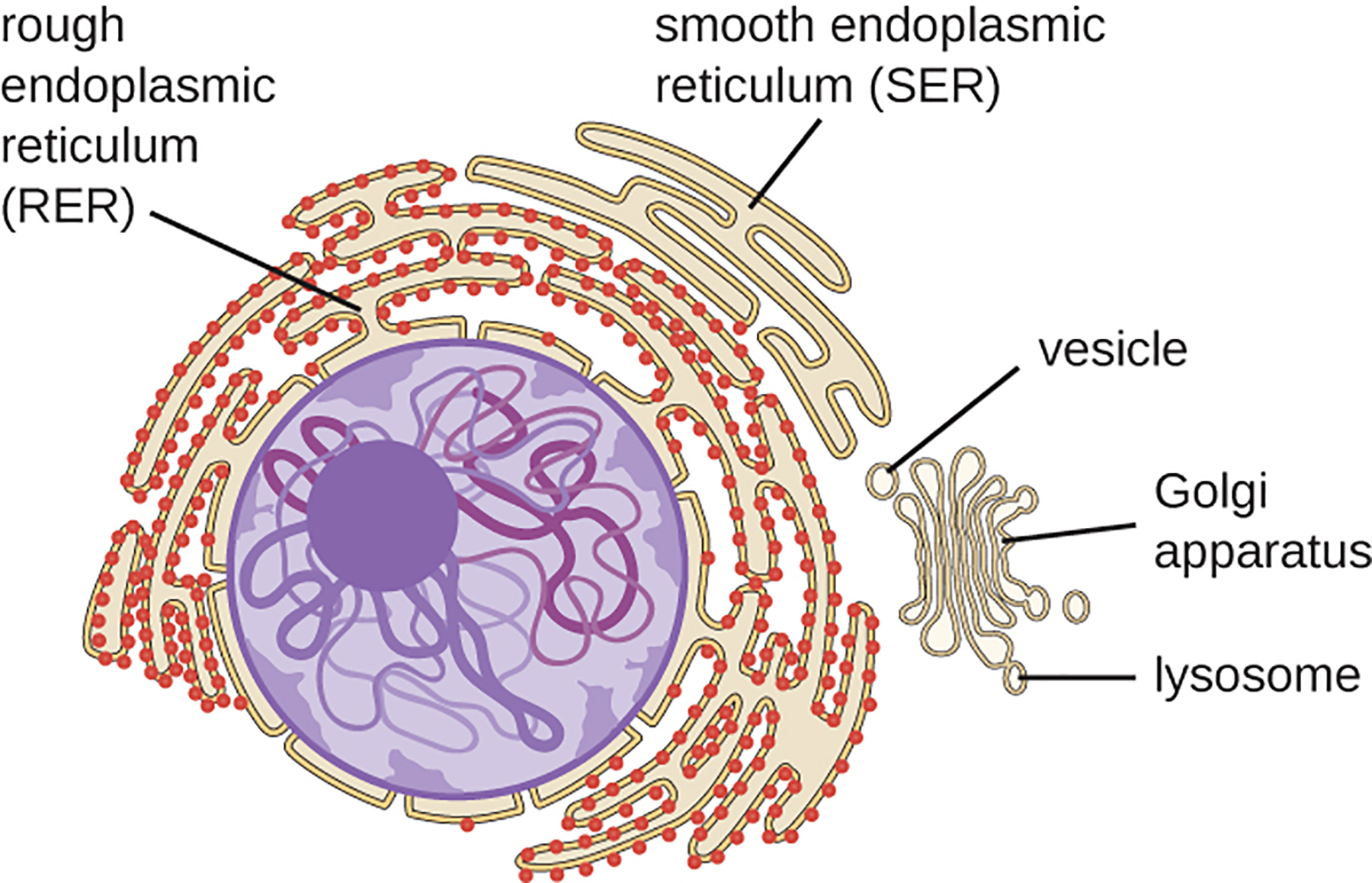
Why do eukaryotic cells require the endomembrane system to transport materials that cannot be dispersed by diffusion alone
Because of their larger cell size

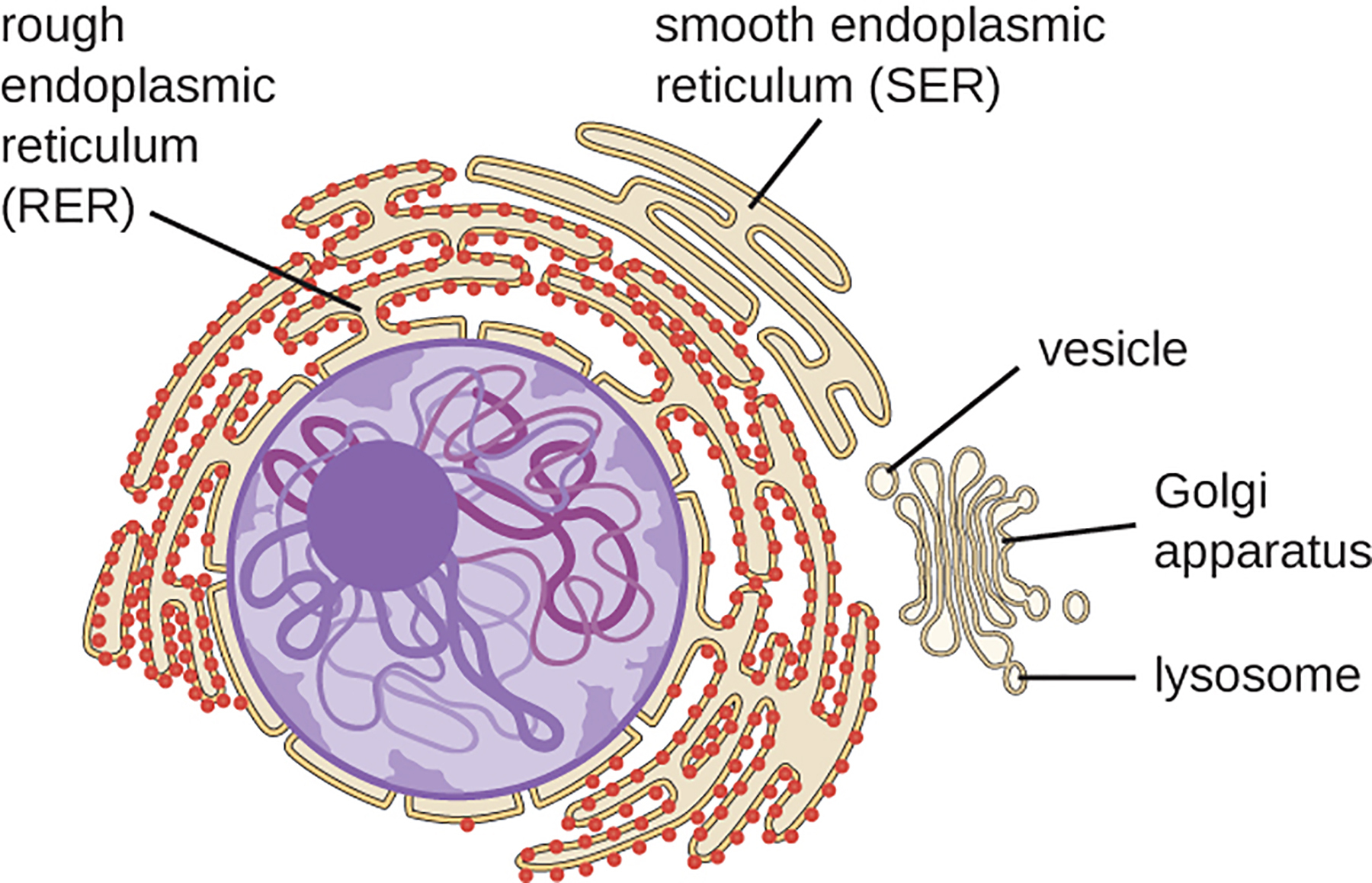
What does the endomembrane system comprise?
several organelles and connections between them, including the endoplasmic reticulum, Golgi apparatus, lysosomes, and vesicles.

What is the endoplasmic reticulum (ER)
an interconnected array of tubules and cisternae (flattened sacs) with a single lipid bilayer
What are cisternae in the ER
membrane-enclosed tubules and sacs

What are the spaces inside of the cisternae called
lumen of the ER
Why are there rough endoplasmic reticulum (RER) and smooth endoplasmic reticulum (SER
These two different types of ER are sites for the synthesis of distinctly different types of molecules
Q: What distinguishes RER from SER?
A: RER is studded with ribosomes on the cytoplasmic side; SER lacks ribosomes.
Q: What is the function of ribosomes on the RER?
A: To synthesize proteins destined for the plasma membrane or secretion.
Q: What happens to proteins synthesized on the RER?
A: They are inserted into the RER membrane, then packaged into transport vesicles.
Q: Where do transport vesicles from the RER go?
A: To the Golgi apparatus, plasma membrane, another organelle membrane, or out of the cell.
Q: What are transport vesicles?
A: Single-lipid bilayer, membranous spheres with hollow interiors that carry molecules.
Q: Why does the SER appear smooth?
A: Because it lacks ribosomes.
Q: What are the functions of the smooth ER (SER)?
A: Biosynthesis of lipids, carbohydrate metabolism, and detoxification of toxic compounds.
Q: Where are transport vesicles made?
A: They are made by the rough endoplasmic reticulum (RER), which buds them off from its membrane after protein synthesis.
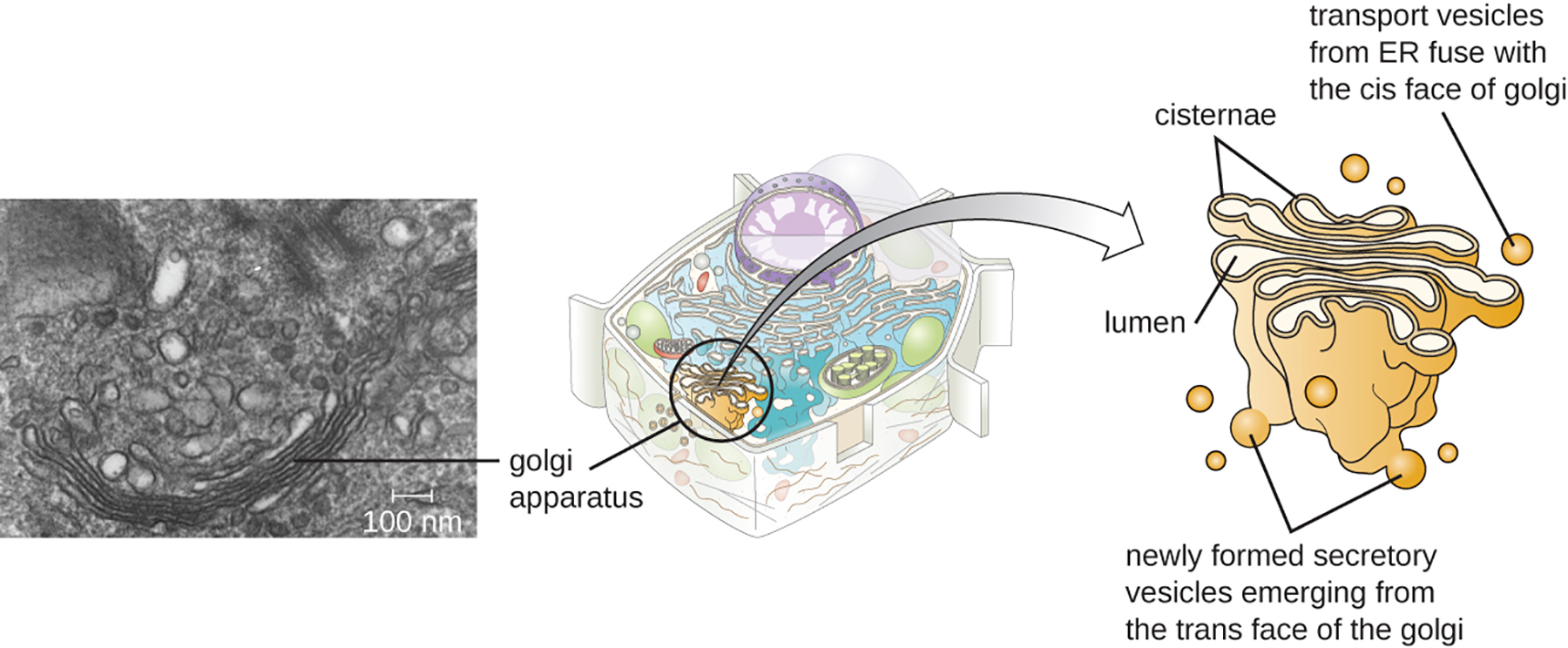
Q: What is the Golgi apparatus composed of?
A: A series of stacked membranous disks, each with a single lipid bilayer.
Q: What does the Golgi apparatus do to lipids and proteins received from the ER?
A: It modifies them, often adding carbohydrate components to form glycolipids, glycoproteins, or proteoglycans
Q: What are glycolipids and glycoproteins important for?
A: Signal recognition by other cells or infectious particles.
Q: How can different types of cells be distinguished?
A: By the structure and arrangement of glycolipids and glycoproteins in their plasma membranes.
Q: What role do glycolipids and glycoproteins often serve on the cell surface?
A: They serve as cell surface receptors.
Q: Where do transport vesicles from the ER fuse with the Golgi apparatus?
A: At the cis (receiving) face of the Golgi.
Q: Where do modified proteins and lipids leave the Golgi apparatus?
A: From the trans (outgoing) face in transport vesicles.
Q: What is exocytosis?
A: The process by which secretory vesicles release their contents to the exterior of the cell.
Q: What is a constitutive secretory pathway?
\\
A: A pathway where secretory vesicles continually release soluble proteins from the cell.
Q: What is a regulated secretory pathway?
A: A pathway where proteins are stored in secretory vesicles and released only in response to specific signals.
Q: Give an example of regulated secretion in the human immune system.
A: Mast cells secrete histamine in response to foreign objects or pathogens.
Q: What does histamine do in the immune response?
A: It triggers various mechanisms used by the immune system to eliminate pathogens.
Q: Why does the ER send lipids and proteins to the Golgi apparatus? Does the ER make them?
A:
Yes, the ER synthesizes proteins and lipids, but they are often not in their final, functional forms yet.
The rough ER (RER) makes proteins (thanks to its ribosomes).
The smooth ER (SER) makes lipids (like phospholipids, steroids).
These newly synthesized molecules are sent to the Golgi apparatus because:
The Golgi modifies them by adding carbohydrate groups (e.g., to form glycoproteins or glycolipids).
It also sorts and packages them for delivery to their correct destinations (e.g., plasma membrane, lysosomes, secretion out of the cell).
Q: Why does the ER send lipids and proteins to the Golgi apparatus?
A: Because the ER synthesizes them, but the Golgi modifies, sorts, and packages them for their final function and destination.
Q: What is regulated secretion?
A: A process where substances are stored in secretory vesicles and released only in response to specific signals (e.g., hormones, nerve impulses).
Q: How does regulated secretion differ from constitutive secretion?
A: Regulated secretion requires a trigger and stores vesicles until needed; constitutive secretion is continuous and does not require a signal.
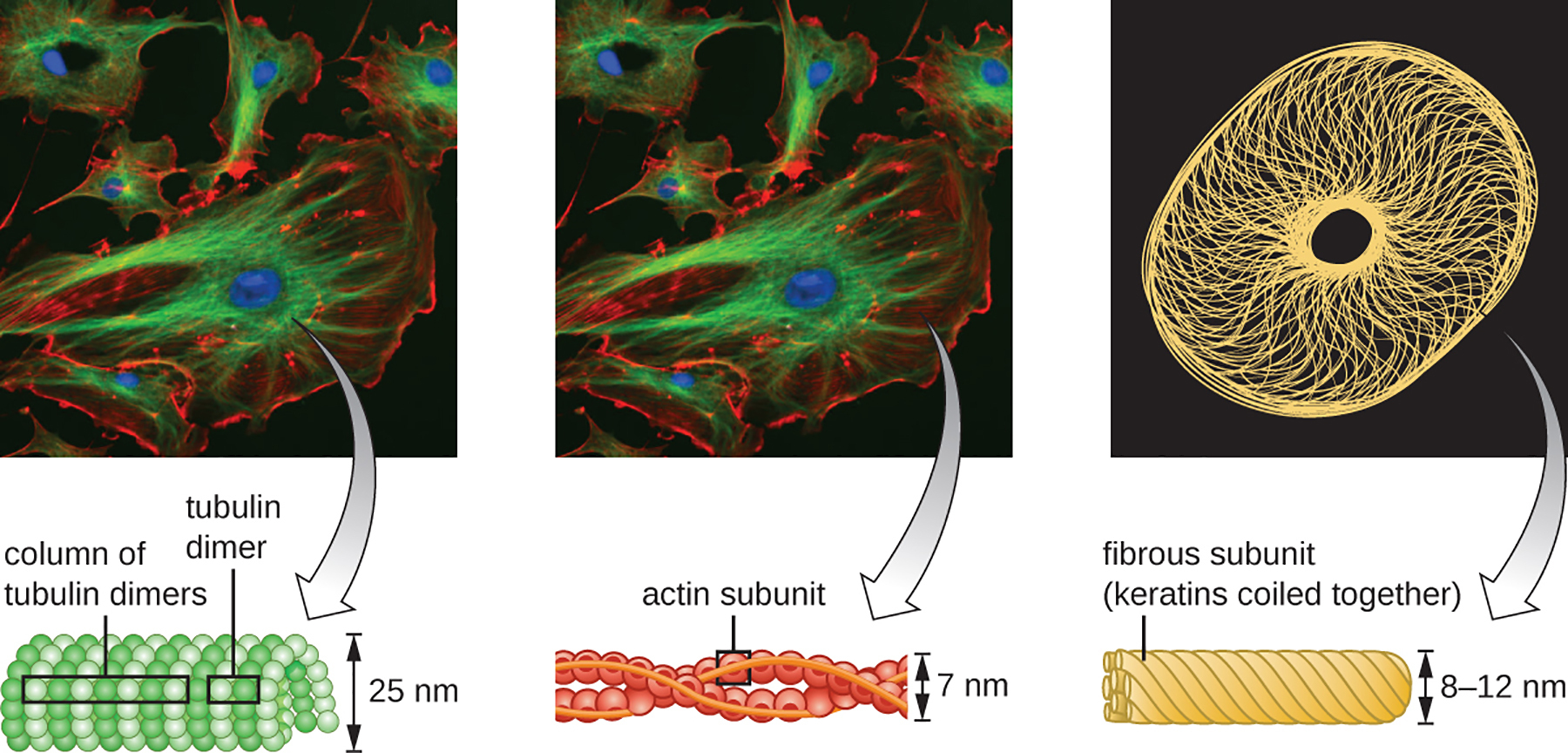
Q: What are the three main components of the cytoskeleton in eukaryotic cells?
A: Microfilaments, intermediate filaments, and microtubules.
Q: What are the two main functions of the cytoskeleton?
A: Providing structural support and serving as a network for transport and organelle anchoring.
Q: How does the cytoskeleton contribute to exocytosis?
A: It provides a pathway for vesicles to move to the plasma membrane to release their contents.
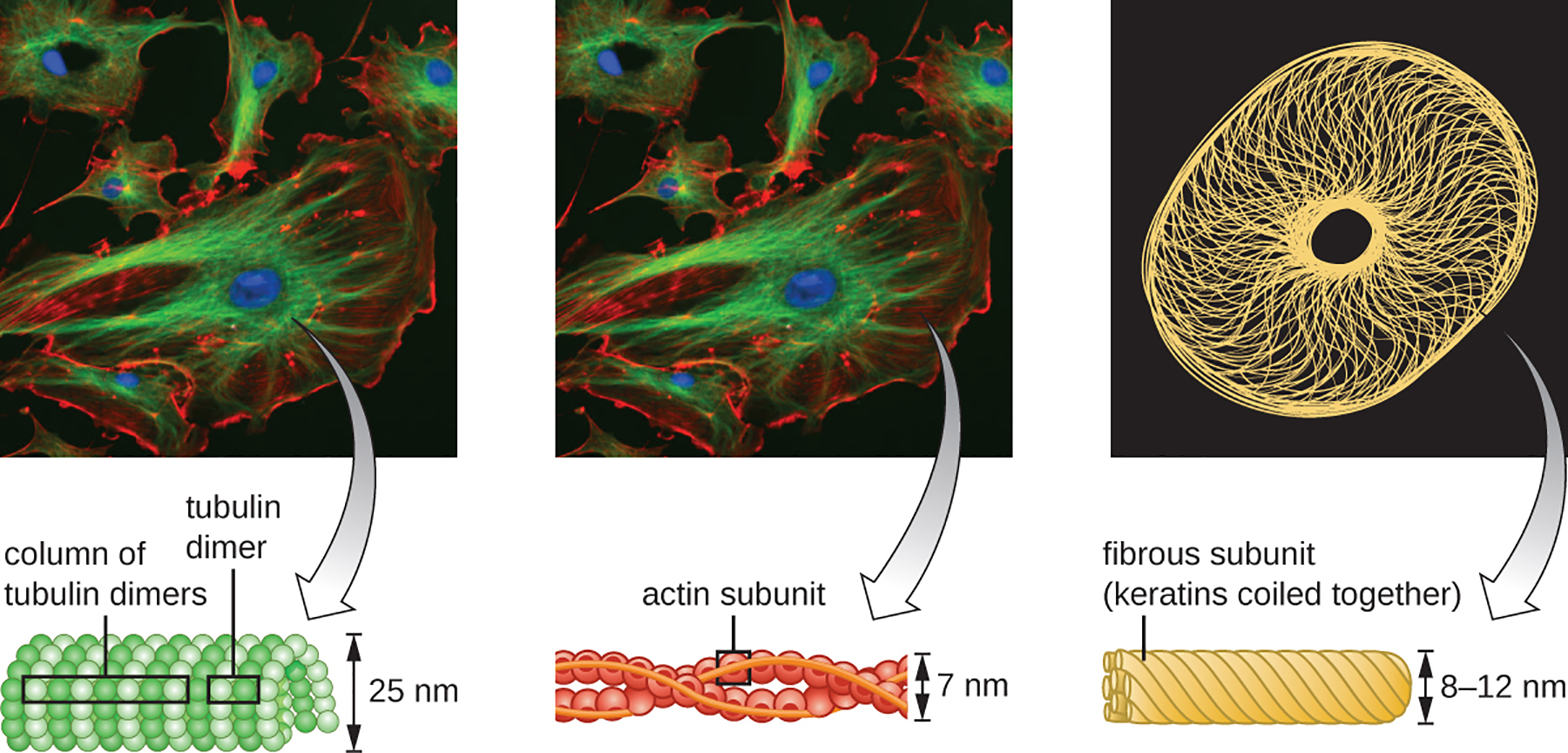
Q: What are microfilaments composed of?
A: Two intertwined strands of actin.
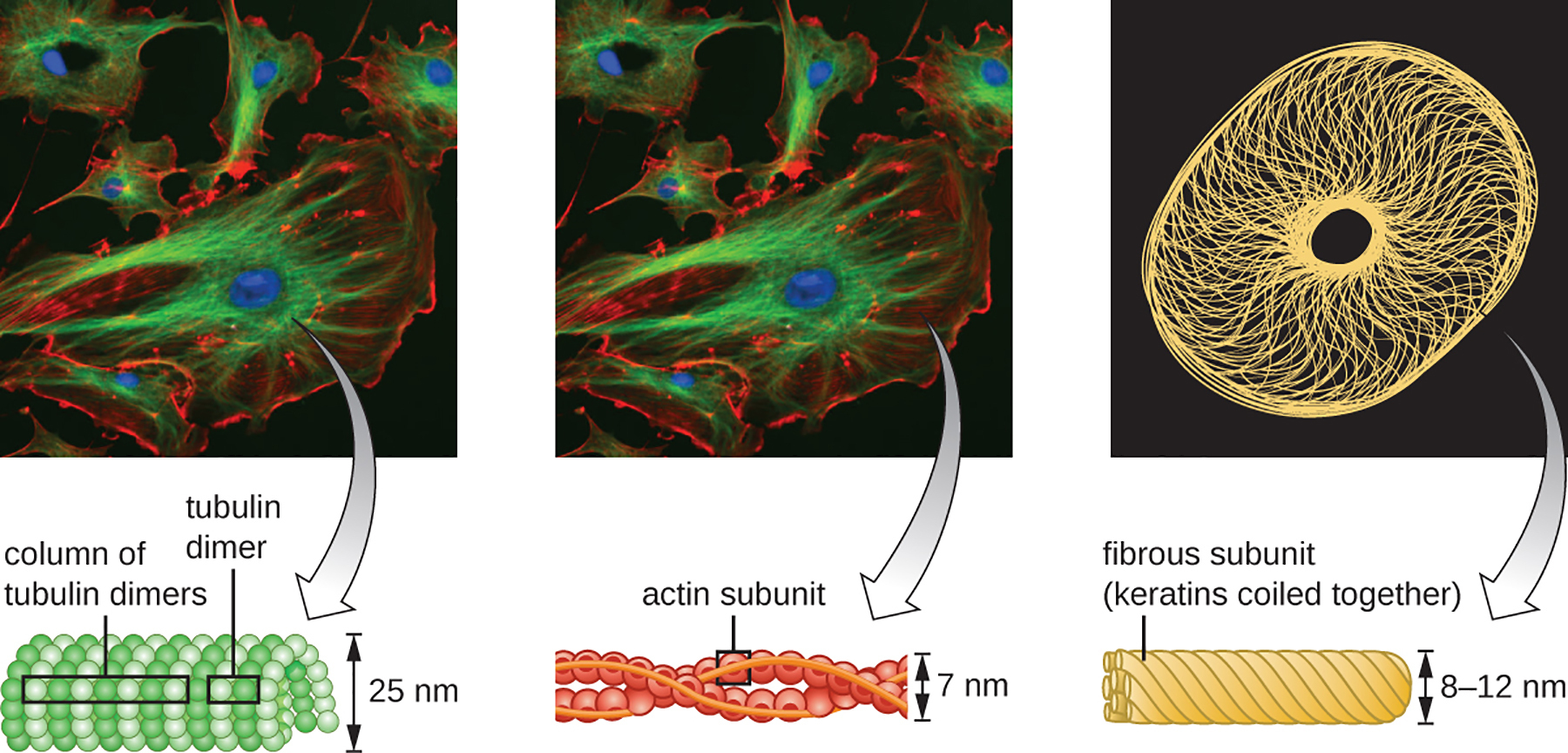
Q: How do microfilaments contribute to muscle contraction and amoeboid movement?
A: Actin filaments work with motor proteins like myosin to enable these movements.
Q: What are the two forms of actin in amoeboid organisms?
A: A stiffer, polymerized gel form and a more fluid, unpolymerized soluble form.
Q: What is the function of actin in the gel form in amoeboid protozoans?
A: It creates stability in the ectoplasm just inside the plasma membrane.
Q: What are pseudopodia, and how are they formed?
A: Temporary membrane extensions formed by the forward flow of soluble actin filaments followed by gel-sol cycling, enabling cell movement.
Q: How do pseudopodia facilitate cell locomotion?
A: The cytoplasm flows forward into the pseudopodium, extending the cell and enabling movement.
Q: What property of microfilaments allows for cell motility and shape changes?
A: Their dynamic ability to polymerize and depolymerize easily in response to cellular signals.
Q: What are intermediate filaments and their main functions?
A: They are cytoskeletal filaments that act as stable cables, maintaining nuclear position and anchoring cells in tissues.